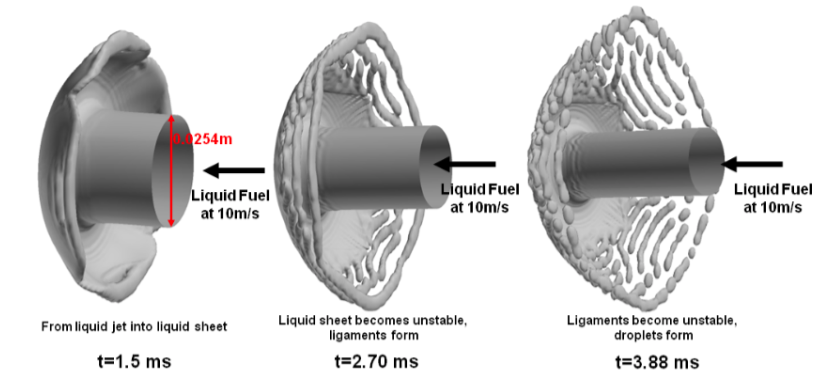VOF Capabilities
The Loci-Stream volume of fluid (VOF) module that is available for users who need to model flows with sharp interface that involve phase change and surface tension. The module is a geometric volume of fluid model that provides capabilities for simulating free-surface and gas-liquid interfacial flows, with a strong focus on accuracy and conservation properties. It's well-suited for handling high-speed compressible flows in three dimensions where the interface topology can change significantly over time. This module has been used in large-scale applications involving tank slosh modeling, ignition over-pressure, plume-water induced side loads for the SLS launch platform, and multiphase launch environment modeling for the SLS launch platform at the Marshall Space Flight Center. Pricing for this module can be found on our pricing page.
The VOF module can operate with grids that comprise arbitrary convex polyhedral cells, allowing it to handle complex geometries effectively. The module is designed for parallel computing, scaling effectively to thousands of processors. This makes it suitable for large-scale simulations without compromising computational speed. It can accurately simulate a broad variety of interfacial flows, including gravity-driven slosh problems, surface tension-driven flows, and flows with compressible gas-phase and liquid-phase. Features for handling heat transfer and phase change are also available in the module.
Conservative Geometric VOF
In the VOF module, the VOF scalar quantity that is used for representing the volume of liquid present per unit volume of a gas-liquid mixture is initialized and transported using purely geometric constructs to maintain a sharp interface at all times. The VOF method consists of three main aspects:
VOF initalization, interface construction, and advection
Evaluation of body forces due to gravity and surface tension
Coupling of body forces, density changes due to pressure, momentum, and energy equations are added in a conservative manner to reduce spurious currents in the gas phase.
Phase Change
The phase change models supported in the VOF module are the Tanasawa model that is driven by the cell and saturation temperature difference, the Hertz-Knudsen model with Clausius-Clapeyron and Antoine models for multicomponent species with partial pressure, and a heat flux balance at an interface based on the thermal gradient from gas and liquid sides at the interface.
VOF Conversion to Lagrangian Particles
The VOF module supports a feature that allows for the transition from VOF droplets to a discrete Lagrangian particles. These particles are then handled by the Lagrangian particle module included in the base Loci-Stream code. This feature allows for simulating the breakup portion of a liquid jet using the VOF module and the disperse portion together, as simulating the entire regime using geometric VOF would be computationally expensive.


